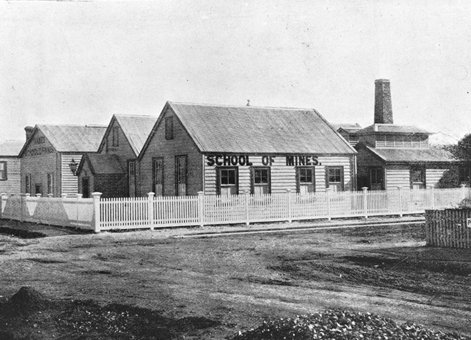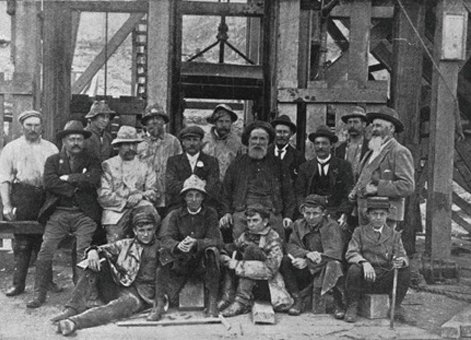Established in 1885, the Thames School of Mines survived until 1954. In its heyday, this was the largest mining school in New Zealand, and for almost 70 years it specialised in practical scientific and industry-focused education.

Thames School of Mines, c.1902, Sir George Grey Special Collections, Auckland Libraries, 7-A8675.
From the 1860s, quartz reef gold mining in Otago and the Hauraki region required ore to be crushed in order to recover gold. There were many levels of technical competence required for this work. To cater to this demand the University of Otago led the way in promoting the establishment of Schools of Mines from 1878.
Thames was the main centre for Hauraki and Coromandel mining. Therefore, it made sense to establish a school there. In the early years branch schools were also established in Coromandel, Waihi, Karangahake and Wairongomai.
The Thames School of Mines, and its counterparts, became increasingly important in New Zealand after the introduction of the 1892 Mining Act. This meant that mine managers were required to have worked in a mine for three years and to have passed the Mine Managers Examination. Study at the Thames School of Mines enabled students to achieve this over a three-year course.
This School was different from others around New Zealand because it had an experimental plant and battery room for crushing ore. From an engineering point of view, the experimental room was an important part of the school’s activities for both students and fee paying industry users. The presence of mercury amalgamation, chlorination and cyaniding plants in the school, equalled those processes actually employed by the mining industry. Therefore, the Thames School of Mines gave students unparalleled practical experience. The school’s facilities also provided opportunities to make advances in processes through experimentation, which the mining industry viewed as an important service.

Pupils of the Thames School of Mines at Opitonui, 1901, Sir George Grey Special Collections.
Other facilities at the school included the Mineralogical Museum, opened in 1901, which displayed the substantial collection of mineral specimens that had been collected since 1870. The school also had a dynamo house created in 1903 to help with practical demonstrations about the science of electricity.
As the mining industry began to decline in the late 19th and early 20th Centuries, the Thames School of Mines kept itself relevant by adding other courses, such as farming orientated classes on chemistry and fertilisers, and courses in Mechanical Drawing, and Mathematics and Electricity to prepare students for work opportunities at large local employers like A and G Price, and Charles Judd Limited.
Many of the school’s contemporaries had closed in the 1890s. Despite the threat of closure in the 1920s, the Thames School of Mines continued until 1954. Then after decades of uncertainty, the buildings and collections were taken on by the New Zealand Historic Places Trust in 1979.
Heritage recognition
This place has been recognised by Heritage New Zealand as a Category 1 historic place (List no.132):
School of Mines Buildings: New Zealand Heritage List/Rarangi Korero information.
Find out more
Access
The Thames School of Mines is a Heritage New Zealand property, which is regularly open to the public.
Further reading
John La Roche, “Thames School of Mines”, IPENZ report (August 2012).
Location
Corner of Brown and Cochrane Streets, Thames, Thames Valley
